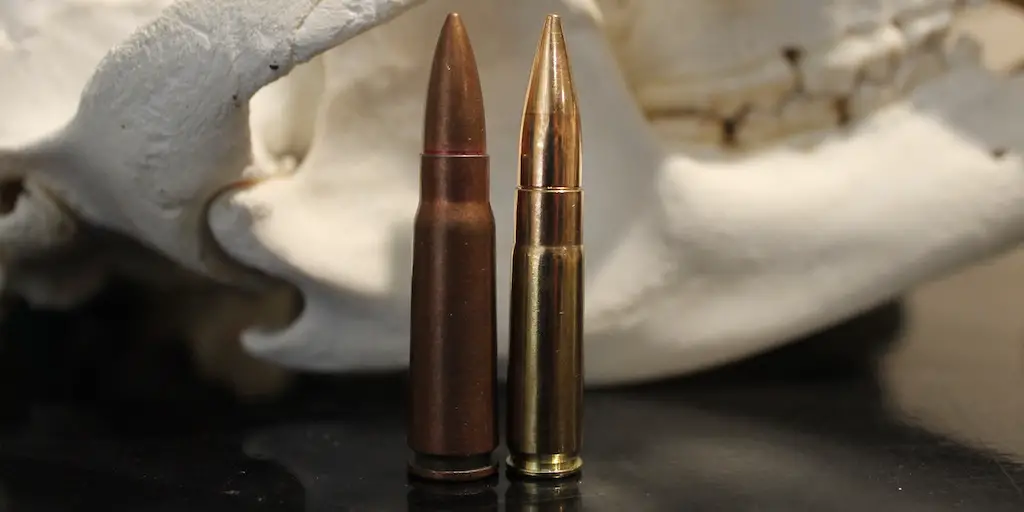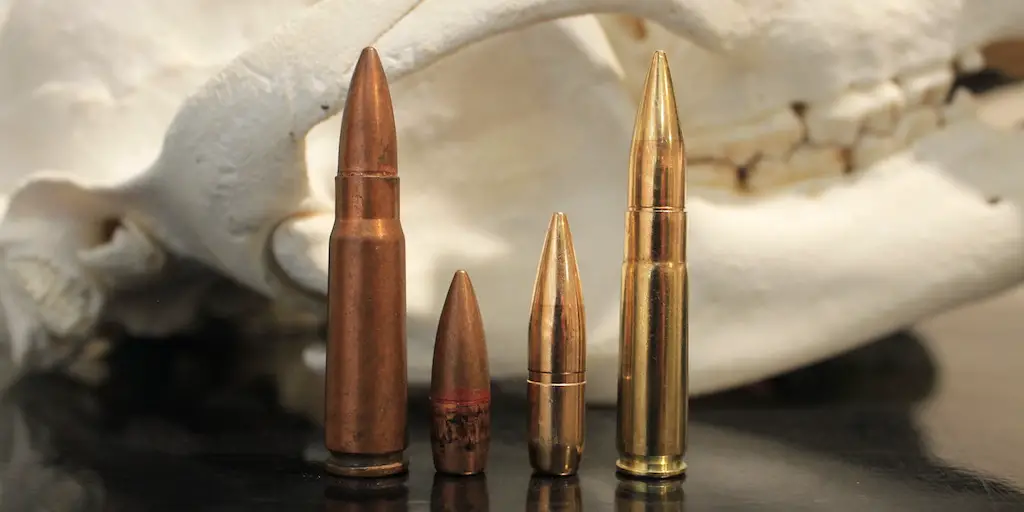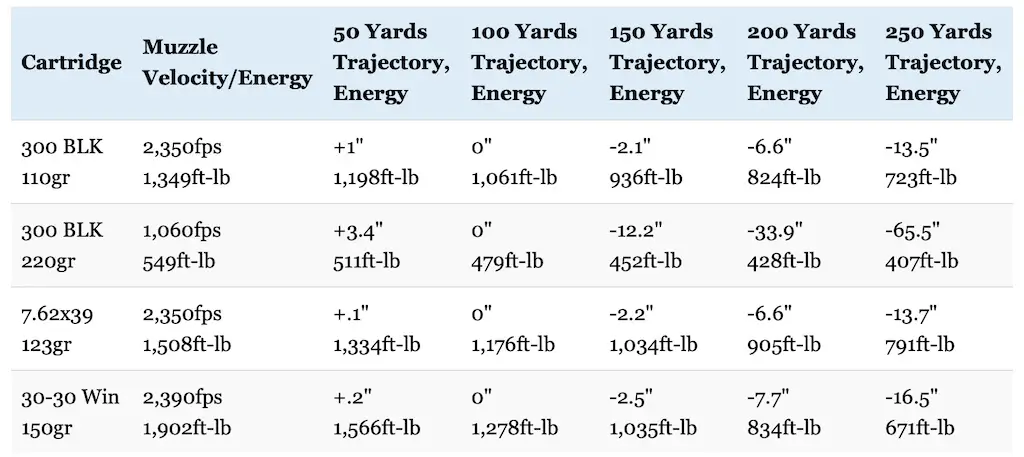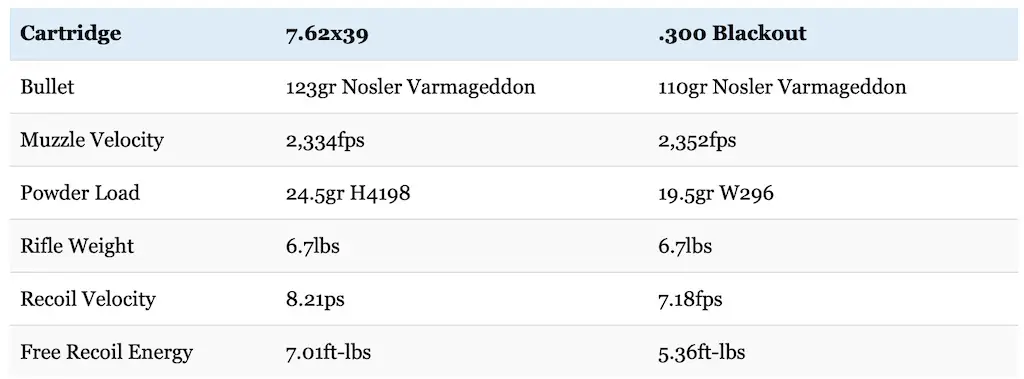NitroX
|
| (.700 member) |
| 29/06/19 05:40 PM |

|
|
|
https://thebiggamehuntingblog.com/300-blackout-vs-7-62x39/
Support the author at the above link.

300 Blackout vs 7.62◊39: Everything You Need To Know
The .300 Blackout and 7.62◊39 cartridges have steadily grown in popularity in recent years. Though they are similar in many ways, each excels in certain situations. Hereís what you need to know about the .300 Blackout vs 7.62◊39.
Many shooters and hunters, particularly those who prefer Modern Sporting Rifles, would probably agree that the .300 Blackout and 7.62◊39 are both effective cartridges that offer certain advantages over the .223 Remington. However, even though there is a big overlap in their capabilities, there are a few key differences between the 7.62◊39 and .300 Blackout that you should be aware of. Additionally, both cartridges are surrounded by a lot of myth and misunderstanding, particularly with regards to their accuracy and suitability for hunting. For those reasons, the .300 Blackout vs 7.62◊39 debate can be difficult to navigate.
In this post, Iím going to investigate the merits of the .300 Blackout vs 7.62◊39 and help you decide which one you should be using in various situations.
Before we get started, I have an administrative note:
Some of the links below are affiliate links. This means I will earn a small commission (at no extra cost to you) if you make a purchase. This helps support the blog and allows me to continue to create free content thatís useful to hunters like yourself. Thanks for your support.
.300 Blackout vs 7.62◊39: History
All of the major combatants used typical full-power cartridges like the .30-06 Springfield, .303 British, 7.92x57mm Mauser, and 7.62x54mmR in their primary infantry rifles at the beginning of World War II. These rifle cartridges were quite powerful and capable of engaging targets at ranges in excess of 600 meters. However, they also had a lot of recoil and were difficult to handle in a fully automatic rifle.
For that reason, the various armies supplemented the rifles the infantry carried with a number of different sub-machine guns chambered in pistol cartridges (like the 7.62x25mm Tokarev, 9mm Luger, and .45 ACP). Full automatic fire was much more controllable with those sub-machine guns, but they didnít have nearly as much stopping power or as long of an effective range as full-powered rifle cartridges.
Since typical combat ranges were typically between 100 and 300 yards, manufacturers set about developing intermediate-power cartridges that were more powerful and had a longer effective range than a pistol cartridge, but had a lighter recoil than full-powered rifle cartridges. The .30 Carbine cartridge used by the US Military in the M1, M2, and M3 Carbines during World War II and Korea was one of the first cartridges adopted by the military to meet those specifications.
The Germans developed the StG 44 rifle and the intermediate 7.92x33mm Kurtz cartridge a few years later during World War II and they had a major impact on the trajectory of firearms design. Indeed, the Soviets were so impressed by the capabilities of the StG 44 and 7.92x33mm Kurtz on the Eastern Front that they decided to develop a similar rifle and cartridge.
The 7.62x39mm (M43) cartridge followed in the ensuring years. The original 7.62x39mm load used by the Soviet Army shot a .311″ 123 grain boat tail full metal jacket (FMJ) bullet at a muzzle velocity of 2,300 feet per second (1,445 foot pounds of energy). With a rimless and highly tapered case to assist with reliable feeding and extraction, the 7.62x39mm rapidly caught on with the Soviet Army. They soon adopted the semi-auto SKS rifle, the RPD machine gun, and the ubiquitous AK-47 assault rifle, which were all chambered in 7.62◊39.
While the Soviets were traveling down that road, the US Military was going through a similar process in searching for a replacement for the .30-06 Springfield. They eventually settled on the M-14 rifle and the 7.62x51mm NATO cartridge as initial replacements for the .30-06 and M-1 Garand.
However, many leaders werenít pleased with the M-14 because it was heavy and difficult to control when firing in full automatic mode. Essentially, it didnít really solve a lot of the issues they had identified with the .30-06 and the M-1 Garand a few years earlier. For those reasons, the the US Air Force, Army, and Marine Corps eventually switched over to the M-16 rifle and the 5.56x45mm cartridge in the 1960s.
To read a more detailed discussion on the reasons the United States made that switch, as well as the differences between the .223 Remington and .308 Winchester cartridges, read this article:
.223 vs 308: Which Is Better For You?
While the M-16 and the 5.56x45mm cartridge had some major teething problems during the Vietnam War, modifications to the rifle and the cartridge itself solved many of those issues and they both remain in service with military forces all over the world today. Even so, many Soldiers and Marines who used the M-16 in combat complained about the poor stopping power of the 5.56x45mm cartridge, particularly the M855 ball load.
These issues led to the development of a series of larger caliber cartridges designed to function in modified AR-15 rifles like the 6.5 Grendel, 6.5 Remington SPC, .458 SOCOM, and the .50 Beowulf.
Around the same time, leaders in the military started to look for a new cartridge that could reliably shoot .30 caliber bullets from an M-16 or M-4 rifle while still using a standard bolt and gas system. Additionally, they wanted a cartridge dimensionally similar enough to the 5.56x45mm that a standard M16/AR magazine could still hold 30 rounds of the new cartridge without any modifications.
They found the solution with the .300 Whisper cartridge. Designed by JD Jones of SSK Industries in the 1990s, the .300 Whisper used a .221 Remington Fireball case necked up to shoot .30 caliber projectiles. However, since the .300 Whisper was a wildcat cartridge, designers at Advanced Armament Corporation (AAC) made a few modifications to the cartridge and got it approved by SAAMI as the .300 AAC Blackout. This allowed the cartridge to enter large scale production with the major ammunition manufacturers.
Also known as the .300 BLK or the 7.62x35mm, the .300 Blackout is available in several different supersonic loads. For instance, Barnes manufactures a load shooting a 110gr TAC-TX at a muzzle velocity of 2,350 feet per second (1,349 foot pounds of energy). Hornady produces a load shooting a 125gr hollow point at 2,175 feet per second (1,313 foot pounds of energy).
At the same time, the .300 Blackout also functions reliably in a suppressed M-16/M-4 (as well as with the AR platform) when using subsonic ammunition like Sellier & Bellotís load shooting a 220 gr FMJ at 1,060 feet per second (549 foot pounds of energy) from a 16″ barrel.
If youíd like to learn more about how the .300 Blackout compares to .223 Remington/5.56x45mm NATO and .308 Winchester, read the article below:
223/5.56 vs 300 Blackout vs 308 Winchester: Which Is Best?
.300 Blackout vs 7.62◊39: Cartridge Sizes
You can see the differences between the 7.62x39mm and .300 Blackout cartridges in the photos below.
One big difference between the two cartridges to keep in mind is that even though they are both classified as .30 caliber cartridges, the 7.62◊39 and .300 Blackout do not use the same diameter bullets. Like most American .30 caliber cartridges (the .30-30 Winchester, .30-06 Springfield, .300 Win Mag, etc.), the .300 Blackout uses .308″ bullets. However, depending on where the specific firearm and ammo in question where manufactured, the 7.62◊39 typically uses .310″ or .311″ bullets. This is because the Russians measure bore diameter differently from Americans (more details on that here).
Though they are similar in overall size, the .300 Blackout has a slightly longer overall length (2.26″ vs 2.2″), but the 7.62x39mm has a slightly longer case length (1.528″ vs 1.368″). The picture below compares a Norinco 7.62x39mm cartridge with a 122gr FMJ bullet to a Sellier & Bellot .300 Blackout cartridge with a 220gr subsonic FMJ bullet. So, while there is a stark contrast in bullet size between the two cartridges in the photo, thatís not the case when the .300 Blackout is using a lighter 125gr bullet.

Additionally, since the .300 Blackout is designed for use with a standard M-16/M-4 bolt, it has the same size rim diameter (.378″) as the .223 Remington/5.56 NATO. The 7.62x39mm cartridge has a larger (.447″) rim diameter, but also has a highly tapered case to facilitate reliable feeding and extraction. Even though the 7.62x39mm cartridge has a more highly tapered case (which is why AK-47 magazines have such an exaggerated curve), the larger rim diameter and longer case of the 7.62x39mm cartridge result in about 45% more case capacity than the .300 Blackout.
Note: while the case capacity figures listed below do give a good indication of the differences between the two cartridges, exact case capacities vary slightly according to the brand of brass used.

7.62◊39 vs 300 Blackout Ballistics
As youíd expect from their similar overall size, the ballistics of the .300 Blackout and 7.62◊39 are pretty similar as well when using similar weight bullets. In fact, theyíre both roughly comparable to the .30-30 Winchester.
However, the .300 Blackout is available in a wide range of bullet weights. So not all .300 BLK loads are created equal.
For instance, the vast majority of 7.62x39mm factory loads shoot bullets in the 120-125 grain range. Of these, 122 grain and 123 grain loads are by far the most common. On the other hand, most .300 Blackout factory loads use bullets in the 78-226 grain range. 110 grain, 120 grain, 125 grain, 150 grain, 208 grain, and 220 grain bullets are the most popular.
As you can see, the table below comparing the 110gr Hornady GMX (.305 BC) and 220gr Sellier & Bellot FMJ subsonic (.330 BC) loads in .300 Blackout to a 123gr Hornady SST (.295 BC) load in 7.62x39mm and a Hornady 150gr RN (.186) in .30-30 Winchester, the ballistics of the three cartridges are pretty similar.

The .30-30 Winchester starts off with significantly more kinetic energy, but the .300 Blackout and 7.62x39mm bullets have a much higher ballistic coefficient. For that reason, the 110gr .300 Blackout and 7.62x39mm loads have a flatter trajectory and retain more energy than the .30-30 out past 200 yards.
The 7.62◊39 has a little more kinetic energy, but the .300 Blackout has a slightly flatter trajectory due to higher ballistic coefficient of the .300 Blackout bullets. For all intents and purposes, there is very little difference in the ballistics of the .300 Blackout and 7.62◊39 because the differences between them are so small with most loads. Thatís obviously not the case with the subsonic .300 Blackout ammo though, which has a very low muzzle velocity and therefore a quite short effective range.
Additionally, the recoil characteristics of the two cartridges are pretty similar as well. When fired from a Ruger Mini-14/Mini-30, the .300 Blackout has slightly less than recoil than the 7.62◊39. That being said, both cartridges have a relatively mild recoil that most shooters should be able to handle without any trouble.
Felt recoil will vary from shooter to shooter and rifle to rifle, but free recoil energy is still a useful way to compare the two cartridges.

The 7.62◊39 has gotten a bad reputation for accuracy over the years. This is probably due to the fact that most people shooting the cartridge are using cheap military surplus ammo. In fact, a good quality SKS or AK is capable of surprisingly good accuracy when using quality ammunition. That being said, even under the best circumstances, the 7.62◊39 is generally at a pretty significant disadvantage in terms of accuracy when compared to the .300 BLK, which is popular for competition shooting in some circles.
Though itís easy to choose a winner when it comes to accuracy of the .300 Blackout vs 7.62◊39 at short range, neither cartridge is really suitable for long distance shooting.
.300 Blackout vs 7.62◊39: Ammunition Selection
Since the .300 Blackout and 7.62x39mm are relatively popular cartridges, there are a number of ammunition manufacturers that produce ammo for both of them like Federal, Fiocchi, Hornady, Sellier & Bellot, and Winchester.
That being said, copper washed FMJ bullets with a steel case produced by Brown Bear, Tula, or Wolf are by far the most common choices for 7.62x39mm ammo out there. These bullets use a steel core and are not allowed at many shooting ranges. However, those same companies (plus others like Federal and Hornady) do make soft point or hollow point 7.62◊39 hunting ammunition as well.
On the other hand, there is a much wider variety of ammunition for the .300 Blackout. This ammo ranges from plain old FMJ and open tip match (OTM) best suited to work at the range on one end of the spectrum to hollow point and ballistic tip ammo designed for hunting and personal protection on the other end.
Prices and availability for each cartridge vary from region to region, but 7.62◊39 ammo is generally much more common and much less expensive than .300 Blackout ammunition.
If youíre into hand loading, then components for the .300 Blackout are much more common, though itís certainly possible to reload for the 7.62◊39 as well. Be careful about trying to reload 7.62x39mm brass though: most of the stuff out there is Berdan primed, which will require different equipment from the Boxer primed brass most American cartridges use. Additionally, while there are tons of good quality .308 caliber bullets to choose from for the .300 Blackout, .310 and .311 bullets for the 7.62◊39 arenít nearly as common (though theyíre out there).
.300 Blackout vs 7.62◊39: Rifle Selection
Both cartridges are most commonly chambered in semi-automatic rifles, which probably has a lot to do with the military use of the two cartridges.
In particular, AR-15 style rifles like those made by Bushmaster, CMMG, Daniel Defense, DPMS, Noveske, Rock River, and Wilson Combat, are extremely popular with the .300 Blackout. This makes sense considering the .300 Blackout was specifically designed for use with that platform. There are a few AR-15 variants chambered in 7.62◊39, but itís not nearly as common. This is because the extreme taper of the cartridge necessitates the use of special magazines and the larger rim diameter of the cartridge requires a new bolt, bolt carrier, firing pin, etc.
On the other hand, the 7.62◊39 is available in a number of AK clones out there as well as a few other rifles like the semi-automatic Ruger Mini-Thirty.
The .300 Blackout is also available in the Ruger Mini-Fourteen and the Remington Model 700 SPS Tactical. Itís even possible to get a .300 AAC Blackout barrel for the single shot Thompson Center Encore.
Both cartridges are available in a few other rifles like the Ruger American Ranch bolt-action rifle.
.300 Blackout vs 7.62◊39: Which Is Right For You?
The 7.62◊39 and .300 Blackout are both well suited for hunting medium game at short to moderate range. The .300 Blackout has a slight advantage here because of its generally better accuracy and larger selection of quality hunting bullets, but theyíll both work for hunting game like deer and feral hogs out to 150 yards or so with good shot placement and when using quality bullets.
Basically, if you consider the .30-30 Winchester adequate for the job, then the .300 Blackout and 7.62◊39 should also do just fine in the same situation.
Use caution when hunting with .300 Blackout subsonic loads though. Those loads can be very accurate, but there are a lot of bad stories about poor terminal performance on deer and feral hogs when using subsonic .300 BLK ammo. Presumably, this is because those loads just donít have enough velocity for the bullets to expand on impact. Instead, they just blow straight through the animal and donít cause much damage.
That being said, Noveske makes a 220 grain subsonic load designed specifically for hunting they claim will work very well on big game. I havenít used it myself, so I canít comment personally on how it works, but it might be worth a try if you really want to hunt with subsonic ammo.
Do you want the ideal cartridge to use with a suppressor or in rifles with short barrels? The .300 Blackout has a big advantage over the 7.62◊39 in those areas. Because the .300 Blackout is designed for use in a